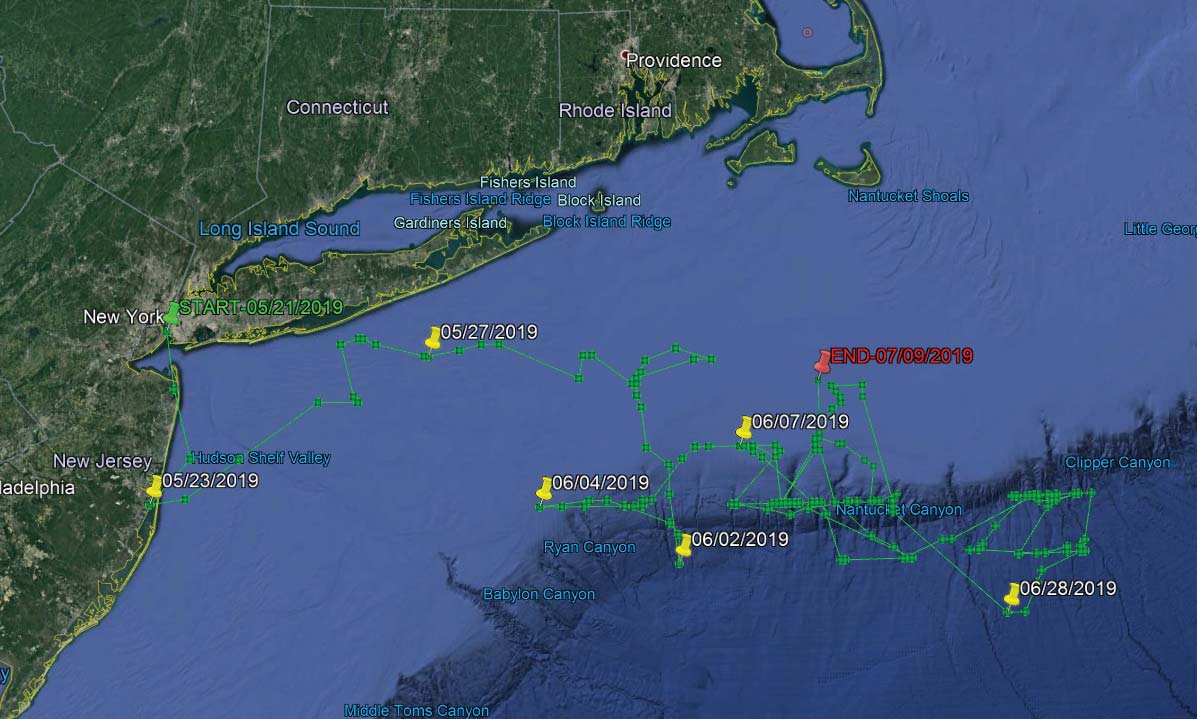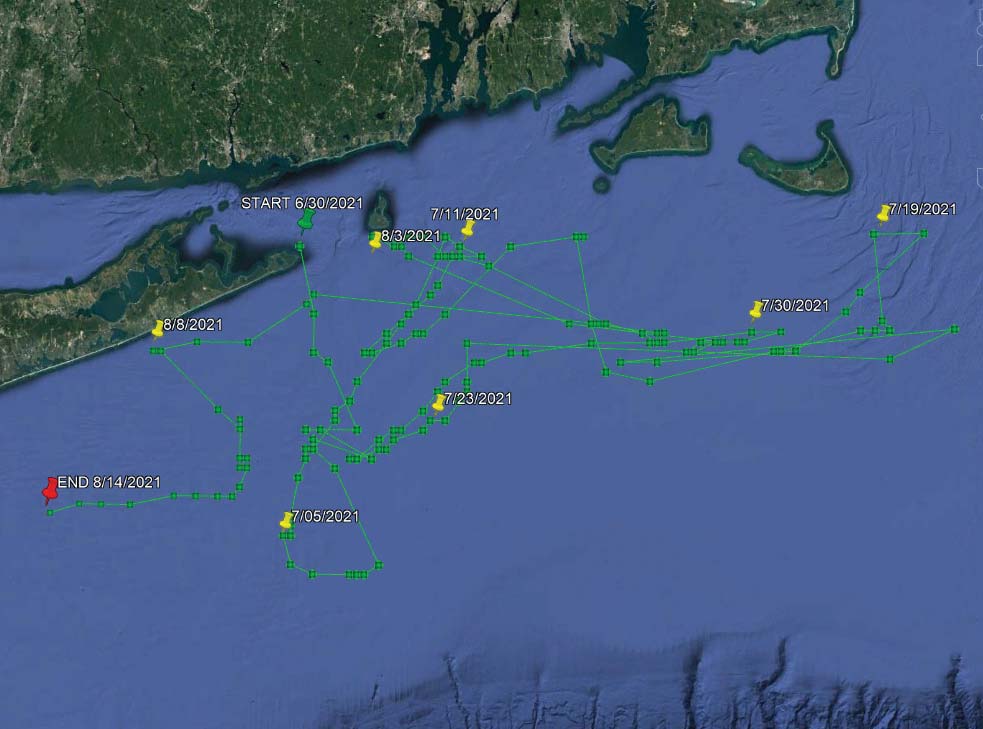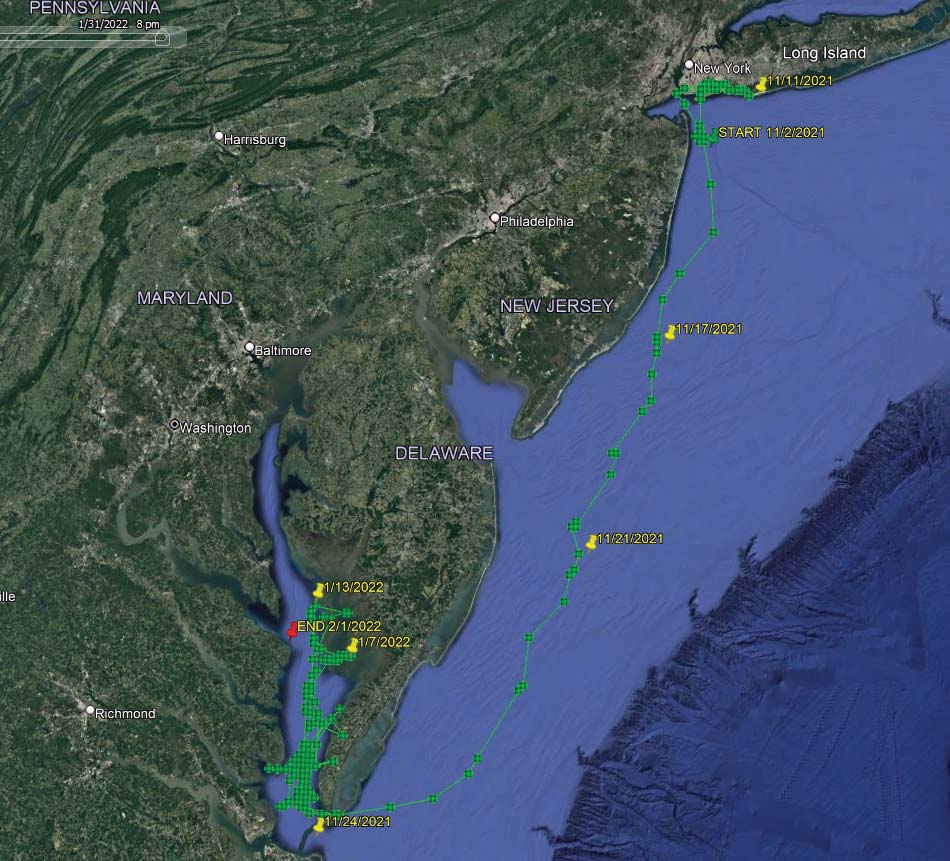
On August 21, research scientists with the National Oceanic and Atmospheric Administration (NOAA) released their annual State of the Climate report which found that ocean heat – measured from the surface to a depth of more than 6,000 feet – was the highest on record in 2021.
The study found that some areas of the North Atlantic registered from 3.6 degrees to 9 degrees warmer than average at times, conditions that have not been observed since record keeping began roughly six decades ago. According to researchers, this persistent rise in ocean water temperatures can have a major impact on marine life, particularly in terms of altering migration patterns of certain fisheries.
So, science says migration patterns are changing due to warming oceans; for anglers along the Striper Coast, this makes a lot of sense.
A Three-Year Timeline
| STUDY SPONSORS |
| The ongoing Northeast Striped Bass Study partnership with Gray Fishtag Research and The Fisherman Magazine would not be possible without the incredible financial support of our sponsors, including American Fishing Wiring (AFW), Berkeley Striper Club, CAT Marine, Fin-Nor, the Fisheries Conservation Trust, Hudson River Fishermen’s Association, LBI Surf Fishing Classic, the Many, Glassberg and Nova families, Montauk Surfcaster Association, PENN, the Raritan Bay Anglers Club, Reel Max Life / NJ SAT Fest, Seaguar, Simrad and Van Staal. To learn more about Gray Fishtag Research and how you can make a tax-deductible charitable donation to the Northeast Striped Bass Study contact Roxanne at 844-824-8353 or [email protected] |
Back in 2019, The Fisherman Magazine and Gray Fishtag Research launched what would become the Northeast Striped Bass Study. From 2019 to 2021, our team deployed 12 MiniPAT satellite tags into a dozen hefty stripers from 34 to 48 inches in length. The unique technology developed by Wildlife Computers out of Redmond, WA collects tracking data through light-based geolocation, diving behavior by way of “time-at-depth” histograms, and temperature profiles which combine profile of depth and temperature.
Out of a dozen tags deployed over a 3-year period, eight have been recovered. “These recoveries have been as interesting and astonishing as the data collected within,” said Roxanne Willmer with Gray Fishtag Research, explaining the benefit of each tag recovery. “When we have the physical tags recovered, we are able to process a 100 percent of the complete data set collected during the tag’s deployment timeframe,” said Willmer, adding “This full data set provides great accuracy for the data studied.”
Even if the tags are not physically recovered, the MiniPAT devices are designed to float to the surface (once a pre-programmed duration period is met, or due to a “pre-mature release” considering all tags do not meet their pre-programmed date) and begin feeding the collected information to an Argos satellite for the duration of battery life which is typically around two weeks.










While the above 10 tags stayed affixed to the fish for enough time to provide a good amount of data to compile charts a few did become disengaged early. “This type of research work comes with significant risk, expense, and at times disappointment if the tag does not perform as we all expected,” noted Gray Fishtag Research president and CEO Bill Dobbelaer.
Two particular striped bass tagged on May 24, 2021 off Sandy Hook proved those inherent risks; one MiniPAT device installed in a fish named Navionics was recovered in Great Kills, Staten Island, NY less than two weeks later on June 11, while another named AFW began an initial upload to the Argos satellite on August 23 near Westerly, RI just as a hurricane was making landfall there (tag whereabouts still unknown).
Dobbelaer added, “We must always remember that fish in the ocean or wild never swim in a straight line and the graphs shown are averages based upon light sensors, temperature, and depth information.”
Status Report For 2022
| NEW FOR ‘22 |
| Satellite tracking tags used in this project are developed by Wildlife Computers. The popularity of the Northeast Striped Bass Study has piqued the interest of Washington-based technology company, resulting in a unique opportunity over the summer of 2022. On August 18, Capt. Guy Buono and I deployed a Wildlife Computers microPAT device in a smaller, 29-inch striper (N40° 36.486’ / W74° 02.350’); the microPAT is a slightly smaller tag with less drag, specifically designed by Wildlife Computers for attachment to small species and/or younger age classes. That was followed up on September 5 in a 32-inch tagged striper off Massachusetts with Chris Scanzillo and Tim Geary (N42° 9.569’ / W70° 41.922’).
As with the MiniPAT and mrPAT devices also used in 2022, the microPAT has been programmed with a pre-set date, and which point the tag should “pop off” from each striper and upload summary of archived data to Argos. According to Wildlife Computers, there has been a great deal of internal and external field testing on these tags to date, and while data is still being collected on how long the tag will transmit the archived data before the battery dies, it is likely to transmit for at least seven days. |
On May 12, 2022, we kicked off our largest Northeast Striped Bass study expedition to date. We were fishing with seven of the best captains and mates along with 30 contributors and sponsors running out of Bahr’s Landing in Highlands, NJ. Our team succeeded in the deployment of three satellite tags:
40-inch striped bass named Pappy Jim
48-inch striped bass named Van Staal
48-inch striped bass named Seaguar Striper.
While Pappy Jim and Van Staal received the standard MiniPAT device, Seaguar Striper employed a new technology under testing in 2022, something called a mrPAT. At just 40 grams, it is the smallest tag in Wildlife Computers pop-up family. Just like the larger MiniPAT devices used up until this point, the mrPAT will automatically deploy when submerged in seawater, and after a specified time interval or on an absolute date, the release pin burns through, separating the tag from its tether. The tag then floats to the surface and begins transmitting to Argos.
As of Labor Day weekend, the folks at Gray Fishtag Research had yet to receive information back from these three striped bass – or, perhaps were still guarded with the data as it continued to compile. But we’re right there at the point where these tags should release from the fish and begin to feed information to the Argos satellite. Once again in 2022, a reward is being offered to anyone who finds either of the MiniPAT devices or the new mrPAT unit.
We expect to bring some of the preliminary data from the tracking in either the November or December edition of The Fisherman. Be sure to hold on to this edition as we compare satellite returns from three years’ worth of the Northeast Striped Bass Study with any new data from 2022 from the likes of Pappy Jim, Van Staal and Seaguar Striper.



